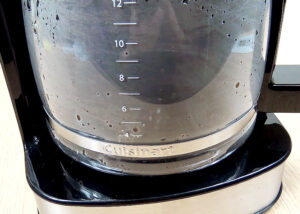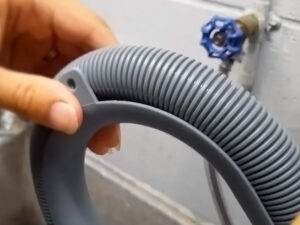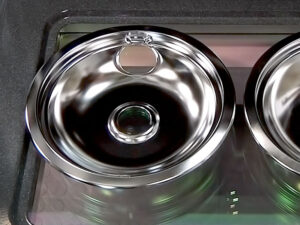The process of cleaning a Dutch oven made of cast iron enamel may appear to be a challenging endeavor; nevertheless, if approached in the appropriate manner, it can be a straightforward and satisfying endeavor.
Cooking utensils made of cast iron enamel are renowned for their longevity and versatility, and if they are properly maintained, they will extend their lifespan.
In this article, we will provide you with detailed instructions on how to effectively clean your cast iron enamel Dutch oven. By doing so, you will be able to maintain the quality of your Dutch oven and continue to enjoy using it for many years to come.

Cast Iron Enamel Dutch Oven: What You Need to Know
Before you start cleaning your cast iron enamel Dutch oven, it’s important to fully understand how it’s constructed. These cooking tools have a strong cast iron core that is coated with a layer of enamel. The enamel on the Dutch oven serves two purposes. It improves the oven’s performance and adds to its attractive appearance.
Enamel has many functional benefits. It provides a surface that food doesn’t stick to, making cooking and cleaning easier and improving the user’s experience. Additionally, the enamel acts as a strong barrier, preventing rust and corrosion on the cast iron underneath. The protective layer is very important for keeping the Dutch oven in good condition as time goes on.
Even though enamel is strong, it can still be damaged if you don’t clean it properly. Using harsh chemicals, abrasive scouring pads, or metal utensils can damage the enamel, causing scratches or chips. Therefore, by understanding how the cast iron core and enamel coating work together, users can clean the Dutch oven in a way that keeps it in good condition and performing well. This will help it last for many years and continue to be a useful tool in the kitchen.
Materials You’ll Need
Before you begin cleaning, gather the following materials:
- Mild dish soap
- Soft-bristle brush or sponge
- Baking soda
- White vinegar
- Soft cloths or towels
- Water
- Stovetop or oven
Step-by-Step Cleaning Guide

1. Cool Down Completely
After using your cast iron enamel Dutch oven, allow it to cool down completely before starting the cleaning process. Placing hot cookware under cold water can lead to thermal shock, potentially damaging the enamel coating.
2. Remove Excess Food Residue
Use a soft-bristle brush or sponge to remove any leftover food particles from the surface of the Dutch oven. Be gentle to avoid scratching the enamel. If there are stubborn bits, a plastic scraper can be used, but never use metal utensils that can damage the enamel.
3. Hand Wash with Mild Dish Soap
Fill the Dutch oven with warm water and add a small amount of mild dish soap. Gently scrub the interior and exterior with a soft-bristle brush or sponge. Avoid using abrasive pads or steel wool, as they can scratch the enamel. Rinse thoroughly to remove all soap residue.
4. Address Stubborn Stains with Baking Soda
For stubborn stains or discoloration, create a paste using baking soda and water. Apply the paste to the stained areas and let it sit for 15-20 minutes. Gently scrub the stained areas with a soft brush or sponge. Baking soda is a mild abrasive that can help lift stains without damaging the enamel.
5. Deal with Burnt-On Residue
If you have burnt-on residue on the bottom of your Dutch oven, fill it with a mixture of water and white vinegar. Bring the mixture to a simmer on the stovetop, allowing it to loosen the burnt-on residue. Once the residue has softened, use a soft-bristle brush to scrub it away.
6. Avoid Harsh Chemicals
Do not use harsh chemicals or abrasive cleaning agents, as they can damage the enamel coating. Stick to mild, natural cleaning solutions to preserve the integrity of your cast iron enamel Dutch oven.
7. Dry Thoroughly
After cleaning, towel-dry your Dutch oven thoroughly to prevent water spots and potential rusting. Ensure that both the interior and exterior are completely dry before storing or using the cookware again.
Tips for Ongoing Maintenance
Maintaining the cleanliness and quality of your cast iron enamel Dutch oven requires consistent care. Here are some tips for ongoing maintenance:
1. Avoid Extreme Temperature Changes
To prevent thermal shock, avoid exposing your Dutch oven to extreme temperature changes. Allow it to cool gradually before cleaning or storing.
2. Use Wooden or Silicone Utensils
When cooking with your cast iron enamel Dutch oven, use wooden or silicone utensils to prevent scratches on the enamel surface. Avoid metal utensils that can cause damage.
3. Season the Cast Iron
While the enamel coating provides a non-stick surface, seasoning the cast iron core can enhance its performance. Apply a thin layer of vegetable oil to the interior of the Dutch oven and heat it in the oven at a low temperature for an hour.
4. Store Properly
Store your cast iron enamel Dutch oven with the lid slightly ajar to allow air circulation. This helps prevent any potential odors or moisture buildup.
Alternative Cleaning Methods
There are alternative methods for cleaning a cast iron enamel Dutch oven, and the approach you choose may depend on personal preferences or the specific condition of your cookware. Let’s explore a few alternative methods:
1. Lemon and Salt Scrub
Create a paste using coarse salt and lemon juice. Apply the paste to the stained or discolored areas and let it sit for 15-20 minutes. The acidity of the lemon helps break down stains, while the salt provides a gentle abrasive action. Scrub the surface with a soft brush or sponge and rinse thoroughly.
2. Boiling Water and Baking Soda Soak
For tough stains or burnt-on residue, fill the Dutch oven with water and add a generous amount of baking soda. Bring the mixture to a boil on the stovetop and let it simmer for 30 minutes. Allow the Dutch oven to cool, then scrub away the residue with a soft brush or sponge. This method helps loosen stubborn particles without the need for harsh chemicals.
3. Vinegar and Baking Soda Paste
Create a paste by mixing baking soda and white vinegar. Apply the paste to the stained areas and let it sit for 30 minutes. The fizzy reaction helps lift stains, making them easier to scrub away. Use a soft brush or sponge to clean the Dutch oven, and rinse thoroughly.
4. Coffee Grounds Absorption
If your Dutch oven has absorbed strong odors from cooking, such as fish or garlic, place a layer of used coffee grounds in the bottom. Let it sit for a few hours or overnight. The coffee grounds will absorb the odors, leaving your Dutch oven smelling fresh. Dispose of the coffee grounds and wash the Dutch oven as usual.
5. Tomato Paste Polish
For a natural polish that enhances the shine of your enamel, apply a thin layer of tomato paste to the interior and exterior of the Dutch oven. Let it sit for 15-20 minutes, then scrub with a soft brush or sponge. Rinse thoroughly to remove any residue.
6. Cornstarch for Stain Removal
Create a paste using cornstarch and water. Apply the paste to stained areas and let it sit for a few hours or overnight. The cornstarch helps absorb stains, making them easier to scrub away. Use a soft brush or sponge to clean the Dutch oven, and rinse well.
Choosing the Right Method
The alternative methods mentioned above provide natural and effective ways to clean your cast iron enamel Dutch oven. When selecting a method, consider the severity of the stains, the materials you have on hand, and any personal preferences for natural cleaning solutions. Experiment with different methods to find the one that works best for your specific cleaning needs. Always remember to rinse thoroughly and dry your Dutch oven completely after cleaning to maintain its quality.
Can I use metal utensils when cooking with a cast iron enamel Dutch oven?
Avoid using metal utensils when cooking with a cast iron enamel Dutch oven. The enamel coating on these cookware pieces is strong, but it can still be damaged. Using metal utensils like spoons, spatulas, or whisks can possibly scratch and damage the enamel, which can weaken it over time.
To keep your Dutch oven’s non-stick enamel in good condition and make it last longer, it’s best to use wooden or silicone utensils. These materials are softer and won’t scratch the enamel. To keep your enamel in good condition, use utensils that are gentle when stirring, serving, or lifting food.
To keep your cast iron enamel Dutch oven looking nice and protect the coating, use wooden or silicone utensils. By taking this precaution, your cookware will last longer and perform better, so you can enjoy its benefits for many years.
Frequently Asked Questions (FAQs)
Is it safe to use dish soap on a cast iron enamel Dutch oven?
Yes, it is safe to use mild dish soap for regular cleaning. Make sure to rinse the Dutch oven thoroughly to remove any soap residue. Avoid using harsh chemicals, as they can damage the enamel coating.
How do I remove burnt-on residue from the bottom of the Dutch oven?
Fill the Dutch oven with a mixture of water and white vinegar, bringing it to a simmer on the stovetop. Once the residue has softened, use a soft brush to scrub it away. Do not use metal tools or abrasive pads.
Can I use oven cleaners or abrasive pads on my cast iron enamel Dutch oven?
No, it is not recommended. Harsh chemicals and abrasive pads can damage the enamel coating. Stick to mild, natural cleaning solutions to preserve the integrity of your Dutch oven.
How do I deal with stubborn stains on the enamel surface?
For stubborn stains, create a paste using baking soda and water or use a mixture of white vinegar and baking soda. Apply the paste to the stained areas, let it sit, and then scrub with a soft brush or sponge.
What’s the best way to dry my cast iron enamel Dutch oven?
Towel-dry your Dutch oven thoroughly after cleaning to prevent water spots and potential rusting. Ensure both the interior and exterior are completely dry before storing or using the cookware again.
Can I use the self-cleaning feature of my oven to clean the Dutch oven?
No, using the self-cleaning feature can expose the enamel to extreme temperatures, leading to potential damage. Stick to manual cleaning methods to preserve the quality of your cast iron enamel Dutch oven.
How often should I season the cast iron core of my Dutch oven?
While the enamel provides a non-stick surface, seasoning the cast iron core can enhance its performance. Consider applying a thin layer of vegetable oil to the interior and heating it in the oven at a low temperature every few months.
What should I do if my Dutch oven develops a metallic taste?
If your Dutch oven develops a metallic taste, it’s possible that the enamel has chipped. In such cases, it is advisable to stop using the cookware and consult the manufacturer for guidance on repair or replacement.
Can I use my cast iron enamel Dutch oven on an induction cooktop?
Most cast iron enamel Dutch ovens are compatible with induction cooktops. However, it’s essential to check the manufacturer’s guidelines to ensure that your specific Dutch oven is suitable for use on induction surfaces.
Conclusion
Cleaning your cast iron enamel Dutch oven is easy and important for keeping it in good condition. Proper cleaning helps it last longer and work better. You can cook with your Dutch oven for many years by following the steps in this guide and keeping up with maintenance. To keep your cast iron enamel Dutch oven in great shape, be gentle, use appropriate tools, and steer clear of strong chemicals. This will help maintain its beauty and functionality.







